Publications
Failure Mode and Effects Analysis in Designing a Virtual Reality-Based Training Simulator for Bilateral Sagittal Split Osteotomy
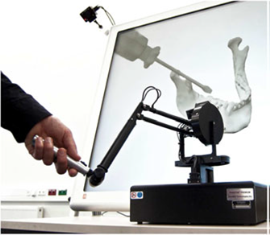
Virtual reality-based simulators offer a cost-effective and efficient alternative to traditional medical training and planning. Developing a simulator that enables the training of medical skills and also supports recognition of errors made by the trainee is a challenge. The first step in developing such a system consists of error identification in the real procedure, in order to ensure that the training environment covers the most significant errors that can occur. This paper focuses on identifying the main system requirements for an interactive simulator for training bilateral sagittal split osteotomy (BSSO). An approach is proposed based on failure mode and effects analysis (FMEA), a risk analysis method that is well structured and already an approved technique in other domains. Based on the FMEA results, a BSSO training simulator is currently being developed, which centers upon the main critical steps of the procedure (sawing and splitting) and their main errors. FMEA seems to be a suitable tool in the design phase of developing medical simulators. Herein, it serves as a communication medium for knowledge transfer between the medical experts and the system developers. The method encourages a reflective process and allows identification of the most important elements and scenarios that need to be trained.
VisNEST – Interactive Analysis of Neural Activity Data
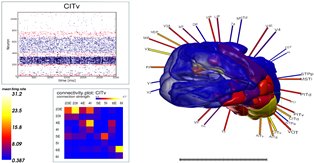
The aim of computational neuroscience is to gain insight into the dynamics and functionality of the nervous system by means of modeling and simulation. Current research leverages the power of High Performance Computing facilities to enable multi-scale simulations capturing both low-level neural activity and large-scale interactions between brain regions. In this paper, we describe an interactive analysis tool that enables neuroscientists to explore data from such simulations. One of the driving challenges behind this work is the integration of macroscopic data at the level of brain regions with microscopic simulation results, such as the activity of individual neurons. While researchers validate their findings mainly by visualizing these data in a non-interactive fashion, state-of-the-art visualizations, tailored to the scientific question yet sufficiently general to accommodate different types of models, enable such analyses to be performed more efficiently. This work describes several visualization designs, conceived in close collaboration with domain experts, for the analysis of network models. We primarily focus on the exploration of neural activity data, inspecting connectivity of brain regions and populations, and visualizing activity flux across regions. We demonstrate the effectiveness of our approach in a case study conducted with domain experts.
Distributed Parallel Particle Advection using Work Requesting
Particle advection is an important vector field visualization technique that is difficult to apply to very large data sets in a distributed setting due to scalability limitations in existing algorithms. In this paper, we report on several experiments using work requesting dynamic scheduling which achieves balanced work distribution on arbitrary problems with minimal communication overhead. We present a corresponding prototype implementation, provide and analyze benchmark results, and compare our results to an existing algorithm.
An Evaluation of Two Simple Methods for Representing Heaviness in Immersive Virtual Environments
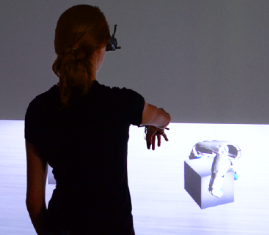
Weight perception in virtual environments generally can be achieved with haptic devices. However, most of these are hard to integrate in an immersive virtual environment (IVE) due to their technical complexity and the restriction of a user's movement within the IVE. We describe two simple methods using only a wireless light-weight finger-tracking device in combination with a physics simulated hand model to create a feeling of heaviness of virtual objects when interacting with them in an IVE. The first method maps the varying distance between tracked fingers and the thumb to the grasping force required for lifting a virtual object with a given weight. The second method maps the detected intensity of finger pinch during grasping gestures to the lifting force. In an experiment described in this paper we investigated the potential of the proposed methods for the discrimination of heaviness of virtual objects by finding the just noticeable difference (JND) to calculate the Weber fraction. Furthermore, the workload that users experienced using these methods was measured to gain more insight into their usefulness as interaction technique. At a hit ratio of 0.75, the determined Weber fraction using the finger distance based method was 16.25% and using the pinch based method was 15.48%, which corresponds to values found in related work. There was no significant effect of method on the difference threshold measured and the workload experienced, however the user preference was higher for the pinch based method. The results demonstrate the capability of the proposed methods for the perception of heaviness in IVEs and therefore represent a simple alternative to haptics based methods.
Research Challenges for Visualization Software
Over the last twenty-five years, visualization software has evolved into robust frameworks that can be used for research projects, rapid prototype development, or as the basis of richly featured, end-user tools. In this article, new take stock of current capabilities and describe upcoming challenges facing visualization software in six categories: massive parallelization, emerging processor architectures, application architecture and data management,data models, rendering, and interaction. Further, for each of these categories, we describe evolutionary advances sufficient to meet the visualization software challenge, and posit areas in which revolutionary advances are required
Virtual Air Traffic System Simulation - Aiding the Communication of Air Traffic Effects
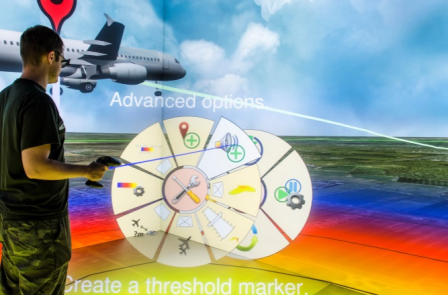
A key aspect of air traffic infrastructure projects is the communication between stakeholders during the approval process regarding their environmental impact. Yet, established means of communication have been found to be rather incomprehensible. In this paper we present an application that addresses these communication issues by enabling the exploration of airplane noise emissions in the vicinity of airports in a virtual environment (VE). The VE is composed of a model of the airport area and flight movement data. We combine a real-time 3D auralization approach with visualization techniques to allow for an intuitive access to noise emissions. Specifically designed interaction techniques help users to easily explore and compare air traffic scenarios.
Extended Pie Menus for Immersive Virtual Environments
Pie menus are a well-known technique for interacting with 2D environments and so far a large body of research documents their usage and optimizations. Yet, comparatively little research has been done on the usability of pie menus in immersive virtual environments (IVEs). In this paper we reduce this gap by presenting an implementation and evaluation of an extended hierarchical pie menu system for IVEs that can be operated with a six-degrees-of-freedom input device. Following an iterative development process, we first developed and evaluated a basic hierarchical pie menu system. To better understand how pie menus should be operated in IVEs, we tested this system in a pilot user study with 24 participants and focus on item selection. Regarding the results of the study, the system was tweaked and elements like check boxes, sliders, and color map editors were added to provide extended functionality. An expert review with five experts was performed with the extended pie menus being integrated into an existing VR application to identify potential design issues. Overall results indicated high performance and efficient design.
Poster: Interactive Visualization of Brain-Scale Spiking Activity
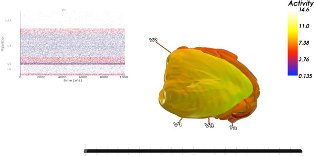
In recent years, the simulation of spiking neural networks has advanced in terms of both simulation technology and knowledge about neuroanatomy. Due to these advances, it is now possible to run simulations at the brain scale, which produce an unprecedented amount of data to be analyzed and understood by researchers. As aid, VisNEST, a tool for the combined visualization of simulated spike data and anatomy was developed.
Adaptive Human Motion Prediction using Multiple Model Approaches
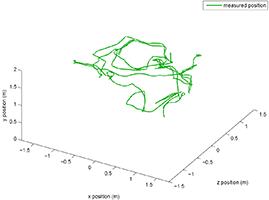
A common problem in Virtual Reality is latency. Especially for head tracking, latency can lead to a lower immersion. Prediction can be used to reduce the effect of latency. However, for good results the prediction process has to be reliably fast and accurate. Human motion is not homogeneous and humans often tend to change the way they move. Prediction models can be designed for these special motion types. To combine the special models, a multiple model approach is presented. It constantly evaluates the quality of the different specialized motion prediction and adjusts the set of motion models. We propose two variants, and compare them to a reference prediction algorithm.
Poster Interactive Visualization of Brain Volume Changes
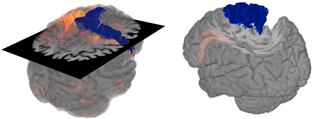
The visual analysis of brain volume data by neuroscientists is commonly done in 2D coronal, sagittal and transversal views, limiting the visualization domain from potentially three to two dimensions. This is done to avoid occlusion and thus gain necessary context information. In contrast, this work intends to benefit from all spatial information that can help to understand the original data. Example data of a patient with brain degeneration are used to demonstrate how to enrich 2D with 3D data. To this end, two approaches are presented. First, a conventional 2D section in combination with transparent brain anatomy is used. Second, the principle of importance-driven volume rendering is adapted to allow a direct line-of-sight to relevant structures by means of a frustum-like cutout.
Poster: Hyperslice Visualization of Metamodels for Manufacturing Processes
In modeling and simulation of manufacturing processes, complex models are used to examine and understand the behavior and properties of the product or process. To save computation time, global approximation models, often referred to as metamodels, serve as surrogates for the original complex models. Such metamodels are difficult to interpret, because they usually have multi-dimensional input and output domains. We propose a hyperslice-based visualization approach, that uses hyperslices in combination with direct volume rendering, training point visualization, and gradient trajectory navigation, that helps in understanding such metamodels. Great care was taken to provide a high level of interactivity for the exploration of the data space.
Physically Based Rendering of the Martian Atmosphere
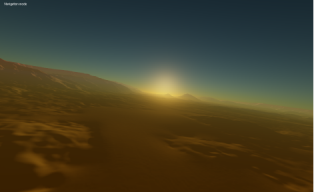
With the introduction of complex precomputed scattering tables by Bruneton in 2008, the quality of visualizing atmospheric scattering vastly improved. The presented algorithms allowed for the rendering of complex atmospheric features such as multiple-scattering or light shafts in real-time and at interactive framerates. While their published implementation corresponding to the publication was merely a proof of concept, we present a more practical approach by applying their scattering theory to an already existing planetary rendering engine. Because the commonly used set of parameters only describes the atmosphere of the Earth, we further extend the scattering formulation to visualize the atmosphere of the planet Mars. Validating the modified scattering and resulting parameters is then done by comparison with available imagery from the Martian atmosphere
Previous Year (2012)

